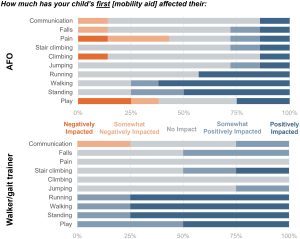Journal Article in Disability and Rehabilitation: Assistive Technology
This research provides insights into the lived experiences of clinicians and caregivers of young children with CP regarding the prescription, provision, use and impact of first mobility aids, specifically ankle foot orthoses and walkers/gait trainers.
 Aim: The purpose of this study was to establish and understand the provision process and impacts of first mobility aids for children with cerebral palsy (CP) in the United States – specifically orthoses, walkers and gait-trainers.
Aim: The purpose of this study was to establish and understand the provision process and impacts of first mobility aids for children with cerebral palsy (CP) in the United States – specifically orthoses, walkers and gait-trainers.
Methods: We performed a mixed-methods study including surveys and semi-structured interviews of caregivers of young children with CP (n = 10) and clinicians who work with young children with CP (n = 29). We used content analysis for the surveys and inductive coding for the interviews.
Results: Four themes emerged: (1) first mobility aids have mixed impacts and use patterns, (2) there is varied caregiver education and understanding about mobility aids, (3) clinician knowledge, consistency and connection impact care and (4) numerous access barriers exist for families, and there are still opportunities for improvement across all domains.
Interpretation: This study not only provides researchers and clinicians with an understanding of the current status of the prescription and provision process in the United States, but also offers suggestions for improvements of the process and mobility aids themselves. These results have implications for future research, mobility aid, design and the provision process of first mobility aids.
